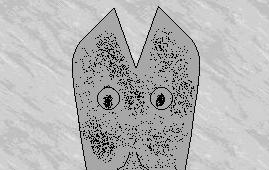It started with a slow drip, drip, drip. Soon, a small chunk of the White House ceiling fell onto the President’s desk. The President contemplated the fallen plaster for a few minutes. Then, he looked at the hole in the ceiling, noting that the sky was overcast, and figuring that it might soon rain. The President cleared the plaster off his desk as best he could and tried to continue reading (a FOR EYES ONLY report on the up-coming Superbowl Game); but, then the droplets started falling on the report, smearing the ink, the President knew what had to be done.
He moved to another desk.
A couple of days later, the President was discussing Weighty Matters of State with the Secretary of Defense who, as usual, was on at length about the need for increased military spending. The President closed his eyes, as if in great concentration, and dreamed of being back on the set of a movie. Any movie. The Secretary of Defense soon stopped talking, and, only half-consciously, the President assumed that he had finished and left.
When, a couple of hours later, the President awoke, he was surprised to find the Secretary of Defense slumped in his chair, unmoving. There was plaster all about, and it only took the President – whose logical thought processes were heightened by odd events – several minutes to figure out that a part of the ceiling had knocked an important member of his Executive Branch unconscious. With a sad sigh, the President realized that he must have the deterioration of the White House roof looked into, and, as soon as he revived the Secretary of Defense, he did so.
The Navy Engineer took almost a week to study the ceiling. In the meantime, chunks continued to fall and, more than once, the President had to move his desk in order to remain sheltered. When, at last, the Navy Engineer was ready to report, half the ceiling was missing. “It is clear,” he stated, occasionally allowing his eyes to wander upwards, “that the entire structure of the White House has been compromised by weak acids in the rainwater…”
The President thought for a moment. “What can we do?” he asked.
The Navy Engineer shifted nervously from one leg to the other. “Well,” he suggested, “as you know, so-called ‘Acid Rain’ is caused by airborne pollutants, largely from industrial smokestacks. Therefore, one answer would be to enforce stricter pollution laws…”
“I see,” the President responded. “But, tell me: if Acid Rain is caused by other factors – natural factors – like, say, the putrefaction of vegetation, wouldn’t we be committing ourselves to a course that would add unnecessary drains on the profits of our economically important industries?”
The Navy Engineer blinked. “Sir,” he weakly protested, “there is more than enough evidence to prove that Acid Rain is primarily caused by industrial and other human pollution.”
“I see,” the President said, once more. In a flash, he knew what had to be done.
He started courtmartial proceedings against the Navy Engineer.
The weather was nice throughout the rest of the week, warm and dry, and only a small portion of the roof fell down, mostly in the far corner, giving the President reason to believe that he had weathered the worst of the problem, and that he could now forget about it.
All the next week, the President was out of the country. When he returned, there was very little of the ceiling left, and part of one wall was missing. “I refuse to allow this minor inconvenience to affect the smooth running of this administration,” the President said to himself, and, later, to the press. Meanwhile, he had his desk moved to what appeared to be the most stable corner of the room.
Later, the Prime Minister of Canada visited the President in his office. Looking around, impressed, the Prime Minister remarked: “You’ve changed something – no, don’t tell me. The place looks…roomier than it used to…”
“I got rid of some of those damn plants,” the President allowed.
After the minimal amount of small talk required by protocol (no more than 15 or 20 minutes), the Prime Minister came directly to the point. “The Great Lakes,” he stated, “are dying. Fish can no longer live in the polluted waters. Something has got to be done about it!”
The President looked genuinely concerned. “What can I do?”
“Both our governments must take serious steps to curb industrial pollution,” the Prime Minister insisted. Just then, the far wall groaned ominously. “What was that?” the Prime Minister anxiously asked.
“The building is settling,” the President assured him. “Nothing to worry about.”
The Prime Minister looked dubious, but continued. “We know that most of the worst pollution comes from your side of the border. Now, what are you prepared to do about it?”
Before the President was forced to reply, the far wall collapsed without further warning, burying the Prime Minister. “Brian?” the President asked, tentatively. “Brian?” There was no reply.
The President’s secretary rushed in. “Sir, are you alright?”
“Fine,” the President answered, “but, I’m afraid that the Prime Minister of Canada is dead.”
“Dead? But…how…?”
“It was a combination of things,” the President pontificated wildly. “Volcanic eruptions obviously weakened the foundation of the White House, and duck droppings must have added to the erosion of the material in the walls…”
“But, sir,” the secretary said, “what are you going to do?”
What, indeed. The President thought for a while, but he knew what had to be done. He had known all along what had to be done. “Get me Drew Lewis,” he ordered his secretary. “We need to study this problem!”


